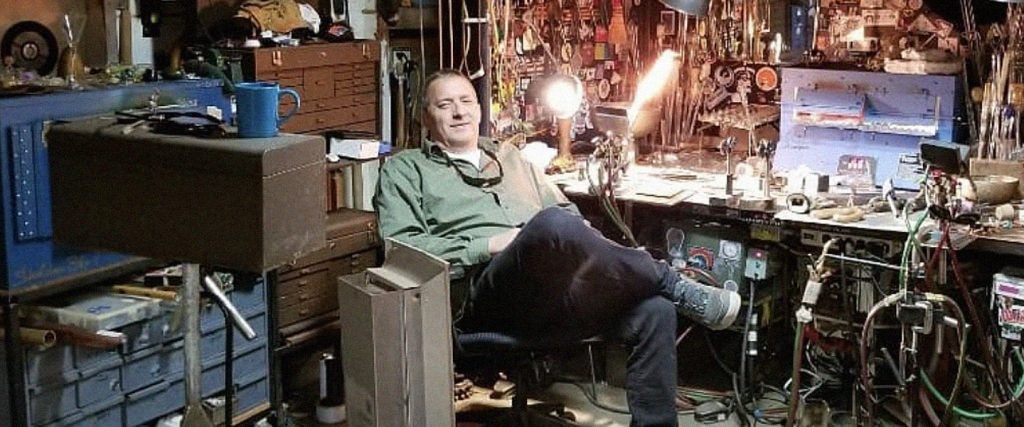October 7, 1993 is a tragically overlooked date in stoner history. On this pivotal day, Schwinn Bicycle Company declared bankruptcy and shuttered its manufacturing plant in Waterford, Wisconsin. The closure would end up compelling the newly jobless 25-year-old Cameron Tower to take a chance on life outside of the Midwest.
“I didn’t have a ton of money, but I was determined to learn glass art,” Tower tells me. “I knew the most talented glass artists were in Eugene, Oregon, so I set out to meet them and learn how to make glass pipes.”
Within a year of landing on the West Coast, Tower would create “the bubbler,” which is now one of the most popular weed-smoking devices in the modern world, and deeply influence the design of the glass bongs more largely.
Granted, Tower isn’t claiming he discovered fire. After all, there’s no shortage of evidence that humans have used different variations of water-filtering apparatuses to smoke their drug of choice since at least the 16th century — if not much, much earlier. In 2015, for instance, archeologists in Russia unearthed 2,400-year-old bongs made of pure gold. There are also plenty of patents for handheld water-filtering smoking devices; one of the earliest of which is inventor George Milkie’s “smoking pipe” from 1920.
In Oregon, Tower worked under the tutelage of Bob Snodgrass, an industry titan who’s largely credited with inventing the popular color-swirled “spoon” shaped glass pipes that he’d sell along tour with the Grateful Dead throughout the 1970s.
“I was one of his first apprentices, and so, I learned everything from him — including the handheld water pipe,” Tower says. Snodgrass had designed a handheld water pipe himself, but it was comprised of multiple pieces, which made it more susceptible to breaking. “Bob’s was a removable down-stem, but I fused the stem to the pipe itself,” Tower explains. “No one had tried it because they assumed you needed the removable stem to clean it, but I was able to make a durable, solid pipe that held water, and that you could still easily keep clean.”
Tower’s design stood apart in its simplicity and singular material. He called it “the bubbler” because smoking from it resulted in a gurgling noise similar to that of a water fountain — and in Tower’s home state of Wisconsin, water fountains are called “bubblers.” “I remember taking some bubblers to a Dead concert for the first time, and people were blown away,” he tells me. “They had the water-cooling hit of a bong, but in a smaller, passable piece the size of a dry pipe. It was both practical and a new phenomenon.”
Within a year, Tower’s bubbler was everywhere. “I couldn’t believe how quickly a pipe I created started a massive trend,” he says. “More people copied it — some made it better in different ways; others were total crap. But today the bubbler is a household name, and that makes me feel honored.”
Tower has a similar attitude about all the contentious claims around who invented the all-glass bong. “I’m not going to take credit for inventing the bong itself, but I do believe I was the first to craft a bong with thick, heavy-walled tubing and a large bottom bubble, which was unique among bongs at the time,” he says. “Next thing you knew, everyone was making bongs that looked like that.”
“Of course, other people want to come in and say they made it first, which is fine,” Tower continues. “There’s no evidence to prove anything, so anyone could lay the claim. But for me, it shows how powerful that scene in the early 1990s was — all of us in Eugene, pushing each other to be more creative, building off each other and trying different, better designs.”
To that end, Tower’s main concern is that the art and ingenuity that drove him and his contemporaries might soon lose out to what’s becoming a highly competitive, billion-dollar industry overwhelmed with expensive tech, celebrity endorsements and luxury branding. “Pipemaking today is all about function and cutting-edge design,” he says. “Not just a simple glass pipe and bubble anymore, now the baseline bong designs are complicated rigs that utilize gravity and ‘recycle’ the water while you inhale.” The style of the glasswork itself has also drifted toward the sterile, replacing swirls of color and vaporized metal “fumes” that accentuated the bongs of yore.
All of which is why he’s doing everything he can to make sure the next generation of artists don’t get pushed out. “Bob Snodgrass paved the way for so many who weren’t trained in scientific glassblowing, so I’m mentoring three artists right now,” he explains. “They’re in their 20s, and they’re wildly talented. They’re able to combine so many styles that started in Eugene 50 years ago with scientific precision to add their own new spin.”
“I was an acetylene welder who fell in love with the glass artwork of Paul Stephan and Harvey Littleton at the Milwaukee Art Museum,” he continues. “Even if I’m just another guy in a factory who blew glass and made no significant contributions, I want to be there to help guide the next regular person like me, the next young artist who could build off of our work and make something great.”
Along those lines, Tower recalls the time he walked into a gas station and saw a bin of $15 bubblers behind the counter. In that moment, it dawned on him just how far the little glass-blown bong from Eugene, Oregon had come — how many artists it had given careers, how many jobs it had created, and maybe most of all, how many bowls it allowed to be smoked.

